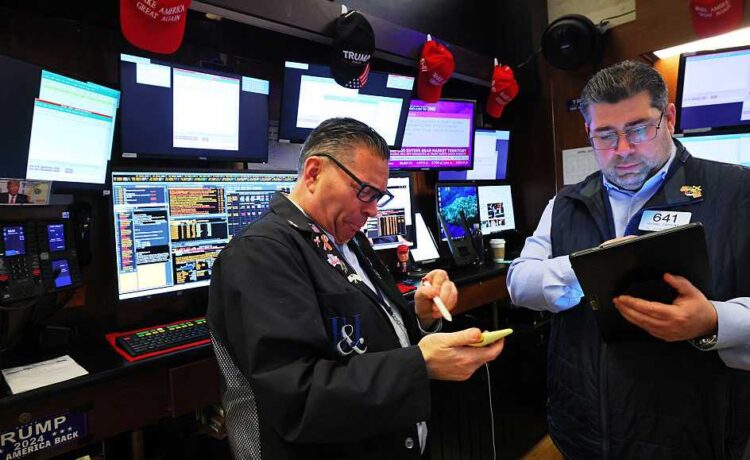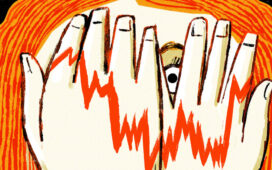Get the Facts: The stock market and other key terms explained
How does the stock market work? Basically, investors need to put their money somewhere to hope that it will grow in value. Now you could stash your money under the mattress, so to speak, but you might be able to get more money. In exchange for giving it to *** company that can do more with your money. So if I have $1 I could put it in the bank savings account, or I could give it to Apple, and they might be better suited to turn that dollar into $5 and that’s the whole point of the stock market is we trust these companies enough, they have proven records and it’s become somewhat of *** staple to our institutions that drive the modern economy to put some money into these, uh, you know, these markets, watch it grow. What is *** bull in *** bear market? Basically they’re used to describe *** bull market is good economy, good market. Things are roaring positive, things are going up, green across the board, and *** bear market is the opposite. *** bear market is when things are declining, very red. We have downward trajectories, the economy is doing bad, the stock market’s doing bad. What is volatility and why is it being thrown around? Why does it matter? Volatility is really important because investors don’t like it. Now volatility is risk, it’s uncertainty, and investors and as economists and finance experts, we love being able to predict things. We don’t want wild swings back and forth in behavior, right? We don’t want to see someone behaving erratically. We want to be able to know our money is safely stored with uh our assets, whether it’s in *** company, whether it’s Apple stock, for instance. And the volatility that the markets are seeing means stocks are all over the place. They’re going up, they’re going down. What are margin calls? How does margin work? Basically, margin works as *** way of borrowing money. You borrow maybe $1000 2000 dollars and you invest it. So maybe you think that now is *** good opportunity to buy, but you don’t have the money to make that purchase. So you go to the institution, you say, hey, I’d like to borrow $2000 and then you’re on margin. That’s *** margin amount of $2000. You put it in the market and you have an IOU on it. So hopefully you see maybe you gain 10% of that investment back over the course of the next month. Great, you’ve made money using money that you didn’t actually have. So now you can capture that profit, repay person who lent you the money, and everything’s great. But what happens if the bet goes bad? You’re still on the hook for paying that loan back. It’s nothing more than *** loan being used in *** fancy way. So you’re borrowing the money and when it’s at risk of not meeting the capital requirements, you will get margin calls. Indexes are typically what we use to get *** big picture, *** bird’s eye view of how the markets are doing. So it’s hard to say, well, what is the market? We use an index typically known as the S&P 500, maybe the Dow Jones Industrial Average, maybe the NASDAQ. So there is These ways of getting *** sense for the overall market as best we can without getting too granular. It’s hard to say that the whole market is doing bad unless you look at these indexes because they proxy for the market. They’re little pieces of every company that’s being traded. Typically with futures, you know, if you’re traded, you want to see how the markets might open up the next day. You could check at 8 p.m. and you see the market futures all pointing towards reds and so. In that case, the margin call might kick in, right? It depends on the exact brokerage you have. The futures are just the expectation of what’s to come, whether it’s the next day or maybe *** week from now, depending on the contract or the asset that’s underlying it. But it’s like crystal ball futures, like it’s looking ahead, not necessarily is going to be how the market opens. Markets tend to open at 9:30 a.m. but it gives you an estimate of how things are looking before the the door to the store opens. Whether it’s *** dead cat bounce or *** dead cow bounce, I’m assuming it’s different animals for the same behavior where markets really quickly deteriorate. They go down, down, down, down, and then you see *** bit of *** brief reprieve, *** spike back up, so maybe they dipped 10%, suddenly they’re up 2%. That could be *** dead cat bounce or dead cow bounce where it’s *** real brief bounce, cause it hit the ground, bounced back up slightly, but then it keeps going back down, right? It’s *** misleading indicator where you think things have finally reversed, things are good again, um, but no, that was just *** brief pause and things continue to go badly. GDP is the gross domestic product. It’s capturing the amount of imports and exports that the country sees that we can better proxy how the country is doing it and whether or not it’s growing. And so we want GDP to go up. We want to be able to say that the economy is doing well. And in that case, we have *** healthy economy. When GDP starts to contract, that’s usually *** decrease in gross domestic product, things we’re producing, selling, consumers responding and consuming as well. And when we see that contraction which we saw recently and we’ll probably see this quarter as well, uh, that’s another indicator that *** recession is inbound because people are buying less. And so if there’s less consumption, less money moving hands. It’s usually not good for *** sustained economic growth, but that tends to happen, right? We have these periods of 8 to 10 years of economic success, things do well, and then there’s always *** contraction that occurs for *** few years afterwards. They come and go. It’s always very painful to be in that, like we’re starting to experience now, but it is normal. It happens and has happened and will continue to happen, um, but yeah, we use GDP to best capture our national performance.
Get the Facts: The stock market and other key terms explained
A dead cat bounce? A bull and bear market? Terms like these have popped up more and more since President Donald Trump’s announcement of tariffs sent shockwaves through the stock market.But what do these words actually mean? The Hearst Television Data Team asked a financial expert to explain how the stock market works and break down key financial terms. Scott Laing is a clinical assistant professor of finance at the University at Buffalo School of Management. He teaches courses in financial modeling, applied economics and advanced corporate finance.Here are his explanations:What is the stock market?The stock market is a trading network that allows investors to buy or sell shares of companies. Typically, investors put their money into the market in hopes that their investments will grow in value.What are bull and bear markets?In simple terms, a bull market refers to a strong market and economy. Prices are rising or are expected to rise, and this trend typically lasts for several months or years.A bear market is the opposite: Stock values and prices are declining. The market is not considered a bear market until it has fallen 20% or more from its recent high. Investors may withdraw their investments during a bear market due to the uncertainty of the decline.What is volatility?Volatility refers to stock prices fluctuating erratically. There is uncertainty or risk in the markets, and according to Laing, investors don’t like it.”Investors, economists and finance experts, we love being able to predict things,” he said. “Volatility is a risk; it’s noise, it’s scary and not exciting.”He compared it to having a part-time job but never knowing what your hours are going to be or when.What are margin calls?If an investor wants to make an investment but doesn’t have the funds, they can request a loan from a financial institution. This loan is known as a margin, essentially borrowed money that’s traded in the market.Investors hope to earn a return on that investment over the following month or so in order to profit and repay the lender. Even if the investment doesn’t turn a profit, the investor is still obligated to repay the loan.A margin call is when a bank or institution demands that the investor repay the borrowed funds. Unlike car or home loans, margin calls often come with higher interest rates and tend to be riskier ventures, according to Laing.What’s a stock index?A stock index provides a bird’s-eye view of how the market is performing. Indexes like the S&P 500, Dow Jones Industrial Average and NASDAQ allow the public to gauge the overall health of the market.What does “dead cat bounce” mean?If the market is sharply declining and then experiences a brief, misleading rebound before continuing to fall, it’s often referred to as a dead cat bounce. The phrase describes a short-lived recovery that doesn’t indicate a true market turnaround.What is the gross domestic product?Gross domestic product measures the total value of goods and services produced within a country. It also reflects the volume of imports and exports and is reported quarterly.When GDP is up, it suggests the economy is healthy and growing. It could be a warning sign of a recession when it’s down. What’s a recession?Recessions are declines in economic activity that last anywhere from a few months to a couple of years. They are marked by high unemployment, reduced consumer spending and decreased production.
A dead cat bounce? A bull and bear market?
Terms like these have popped up more and more since President Donald Trump’s announcement of tariffs sent shockwaves through the stock market.
But what do these words actually mean? The Hearst Television Data Team asked a financial expert to explain how the stock market works and break down key financial terms.
Scott Laing is a clinical assistant professor of finance at the University at Buffalo School of Management. He teaches courses in financial modeling, applied economics and advanced corporate finance.
Here are his explanations:
What is the stock market?
The stock market is a trading network that allows investors to buy or sell shares of companies. Typically, investors put their money into the market in hopes that their investments will grow in value.
What are bull and bear markets?
In simple terms, a bull market refers to a strong market and economy. Prices are rising or are expected to rise, and this trend typically lasts for several months or years.
A bear market is the opposite: Stock values and prices are declining. The market is not considered a bear market until it has fallen 20% or more from its recent high. Investors may withdraw their investments during a bear market due to the uncertainty of the decline.
What is volatility?
Volatility refers to stock prices fluctuating erratically. There is uncertainty or risk in the markets, and according to Laing, investors don’t like it.
“Investors, economists and finance experts, we love being able to predict things,” he said. “Volatility is a risk; it’s noise, it’s scary and not exciting.”
He compared it to having a part-time job but never knowing what your hours are going to be or when.
What are margin calls?
If an investor wants to make an investment but doesn’t have the funds, they can request a loan from a financial institution. This loan is known as a margin, essentially borrowed money that’s traded in the market.
Investors hope to earn a return on that investment over the following month or so in order to profit and repay the lender. Even if the investment doesn’t turn a profit, the investor is still obligated to repay the loan.
A margin call is when a bank or institution demands that the investor repay the borrowed funds. Unlike car or home loans, margin calls often come with higher interest rates and tend to be riskier ventures, according to Laing.
What’s a stock index?
A stock index provides a bird’s-eye view of how the market is performing. Indexes like the S&P 500, Dow Jones Industrial Average and NASDAQ allow the public to gauge the overall health of the market.
What does “dead cat bounce” mean?
If the market is sharply declining and then experiences a brief, misleading rebound before continuing to fall, it’s often referred to as a dead cat bounce. The phrase describes a short-lived recovery that doesn’t indicate a true market turnaround.
What is the gross domestic product?
Gross domestic product measures the total value of goods and services produced within a country. It also reflects the volume of imports and exports and is reported quarterly.
When GDP is up, it suggests the economy is healthy and growing. It could be a warning sign of a recession when it’s down.
What’s a recession?
Recessions are declines in economic activity that last anywhere from a few months to a couple of years. They are marked by high unemployment, reduced consumer spending and decreased production.






